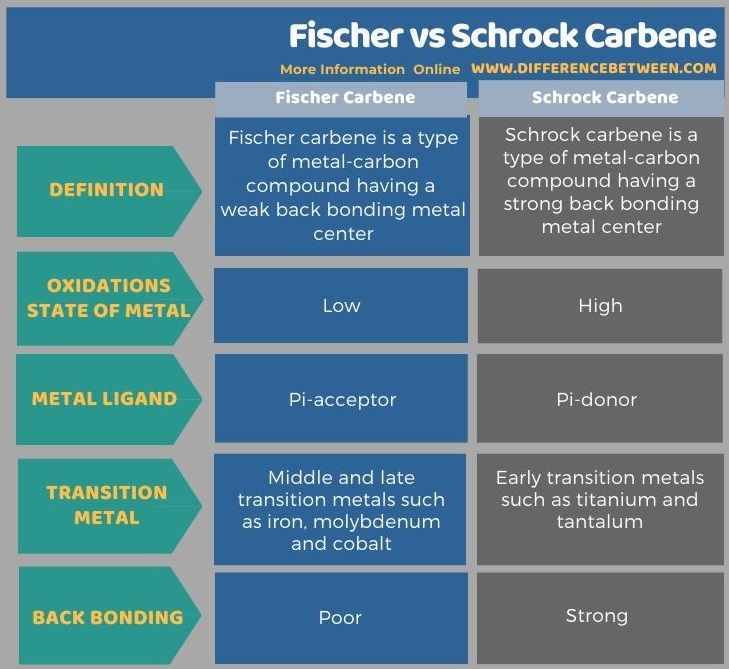Difference Between Fischer and Schrock Carbene
The key difference between Fischer and Schrock carbene is that Fischer carbene contains a weak back bonding metal whereas Schrock carbene contains a strong back bonding metal.
A carbene compound is a chemical compound containing a neutral carbon atom having a valency of two and two unshared valence electrons. The general formula of a carbene is R=R’ or R=C where R represents either substituents or hydrogen atoms. There are two different types of carbene as Fischer carbene and Schrock carbene.
CONTENTS
1. Overview and Key Difference
2. What is Fischer Carbene
3. What is Schrock Carbene
4. Side by Side Comparison – Fischer vs Schrock Carbene in Tabular Form
5. Summary
What is Fischer Carbene?
Fischer carbene is a type of metal-carbon compound having a weak back bonding metal center. This metal center is usually a low oxidation state metal center. The middle and late transition metals of the transition series such as iron, molybdenum and cobalt can be found in these carbene molecules. Also, these compounds contain pi-donating R groups. In other words, Fischer carbenes contain pi-acceptor metal ligands. The most common R groups include alkoxy and alkylated amino groups.

Figure 01: Chemical Bonding in Carbene Compounds
Fischer carbene molecules are related to ketones in the chemical properties because the carbon atom in the carbene is electrophilic similar to the carbonyl carbon of ketone molecule. Moreover, similar to the ketones, Fischer carbenes can undergo aldol-like reactions. Further, the carbon atom that is alpha to the carbene-carbon is acidic and can be deprotonated by bases such as n-butyllithium.
What is Schrock Carbene?
Schrock carbene is a type of metal-carbon compound having a strong back bonding metal center. These carbene compounds do not have pi-accepting metal ligands. However, there are pi-donating ligands. At the carbene-carbon center, this compound is nucleophilic. Typically, we can observe a high oxidation state metal center in these compounds. Mostly, the early transition metals such as titanium and tantalium can be found in these compounds.
What is the Difference Between Fischer and Schrock Carbene?
A carbene compound is a chemical compound containing a neutral carbon atom having a valency of two and two unshared valence electrons. There are two different types of carbene as Fischer carbene and Schrock carbene. The key difference between Fischer and Schrock carbene is that Fischer carbene contains a poorly back bonding metal whereas Schrock carbene contains a strongly back bonding metal.
Furthermore, usually, Fisher carbene compounds contain low oxidation state metal centers while Schrock carbene centers contain high oxidation state metal centers. Therefore, Fischer carbenes typically contain middle and late transition metals such as isorn, molybdenum, and cobalt while Schrock carbenes typically contain early transition metals such as titanium and tantalum. Thus, this is another difference between Fischer and Schrock carbene.
Moreover, Fischer carbene contains pi-acceptor metal ligands while Schrock carbene compounds contain pi-donor metal ligands. In other words, Fischer carbene contains pi-donating R groups. Hence, this is also a significant difference between Fischer and Schrock carbene. Apart from that, Fischer carbene compounds can act as electrophiles because they are electrophilic at carbene-carbon center. However, Schrock carbenes are nucleophilic compounds. Besides, R groups of Fischer carbene include alkoxy and alkylated amino groups while R groups of Schrock carbene include hydrogen and alkyl substituents.
Below infographic summarizes the differences between Fischer and Schrock carbene.

Summary – Fischer vs Schrock Carbene
There are two different types of carbene as Fischer carbene and Schrock carbene. Fischer carbene is a type of metal-carbon compound having a weak back bonding metal center while Schrock carbene is a type of metal-carbon compound having a strong back bonding metal center. Therefore, the key difference between Fischer and Schrock carbene is that Fischer carbene contains a poorly back bonding metal whereas Schrock carbene contains a strongly back bonding metal.
Reference:
1. “Carbenes.” Chemistry LibreTexts, Libretexts, 5 June 2019, Available here.
2. “Transition Metal Carbene Complex.” Wikipedia, Wikimedia Foundation, 14 Jan. 2020, Available here.
Image Courtesy:
1. “Bonding scheme carbene radical” By Teun71 – Own work (CC BY-SA 4.0) via Commons Wikimedia
ncG1vNJzZmivp6x7pbXFn5yrnZ6YsqOx07CcnqZemLyue8OinZ%2Bdopq7pLGMm5ytr5Wau26yyKyaoZ2iYq6vsIysmqGqn5i4bq%2FAq5meppVk